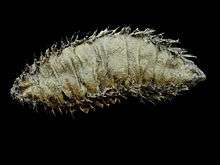Aphrodita
Aphrodita, or sea mouse, is a genus of marine polychaete worms found in the Mediterranean sea and the eastern and western Atlantic Ocean.[2]
| Aphrodita | |
|---|---|
.jpg) | |
| Aphrodita aculeata | |
| Scientific classification | |
| Kingdom: | |
| Phylum: | |
| Class: | |
| Order: | |
| Suborder: | Aphroditoidea |
| Family: | Aphroditidae |
| Genus: | Aphrodita |
| Type species | |
| Aphrodita aculeata Linnaeus, 1758 | |
| Species | |
|
See text | |

Etymology
The name of the genus is taken from Aphrodite, the Ancient Greek goddess of love. This is because, when viewed ventrally, the animal resembles a human female's genitalia. The English name may either have a similar meaning, or may derive from the supposed resemblance to a bedraggled mouse when washed up on shore.[3]
Description
The body of the sea mouse is covered in a dense mat of parapodia and setae (hairlike structures).[2] Adults generally fall within a size range of 7.5 to 15 centimetres (3.0 to 5.9 in), but some grow to 30 centimetres (12 in). The sea mouse have two pairs of feeler-like appendages close to their mouth and they do not have eyes. Locomotion is carried out by several small, bristly, paddle-like appendages. They are hermaphroditic which means that they have functional reproductive organs of both sexes. The eggs of one individual are fertilised by the sperm of another.[4]
Structural coloration
The spines, or setae,[2] on the scaled back of the sea mouse are one of its unique features. Normally, these have a deep red sheen, warning off predators, but when the light shines on them perpendicularly, they flush green and blue, a "remarkable example of photonic engineering by a living organism". This structural coloration is a defense mechanism, giving a warning signal to potential predators. The effect is produced by many hexagonal cylinders within the spines, which "perform much more efficiently than man-made optical fibres".[5]
Feeding
Aphrodita are typically scavengers.[2] However, Aphrodita aculeata is an active predator,[6] feeding primarily on small crabs, hermit crabs and other polychaete worms including Pectinaria and Lumbriconereis.[6]
Species
Species recognized by the World Register of Marine Species:[1]
- Aphrodita abyssalis Kirkegaard, 1996
- Aphrodita aculeata Linnaeus, 1758
- Aphrodita acuminata Ehlers, 1887
- Aphrodita alta Kinberg, 1856
- Aphrodita annulata Pennant, 1777
- Aphrodita aphroditoides (McIntosh, 1885)
- Aphrodita armifera Moore, 1910
- Aphrodita audouini Castelnau, 1842<'small>
- Aphrodita australis Baird, 1865
- Aphrodita bamarookis Hutchings & McRae, 1993
- Aphrodita bisetosa Rozbaczylo & Canahuire, 2000
- Aphrodita brevitentaculata Essenberg, 1917
- Aphrodita californica Essenberg, 1917
- Aphrodita clavigera Freminville, 1812
- Aphrodita daiyumaruae Imajima, 2005
- Aphrodita decipiens (Horst, 1916)
- Aphrodita defendens Chamberlin, 1919
- Aphrodita diplops Fauchald, 1977
- Aphrodita echidna Quatrefages, 1866
- Aphrodita elliptica
- Aphrodita falcifera Hartman, 1939
- Aphrodita goolmarris Hutchings & McRae, 1993
- Aphrodita hoptakero Otto in Audouin & Milne Edwards, 1832
- Aphrodita japonica Marenzeller, 1879
- Aphrodita kulmaris Hutchings & McRae, 1993
- Aphrodita limosa (Horst, 1916)
- Aphrodita longicornis Kinberg, 1855
- Aphrodita longipalpa Essenberg, 1917
- Aphrodita macroculata Imajima, 2001
- Aphrodita magellanica Malard, 1891
- Aphrodita malayana (Horst, 1916)
- Aphrodita malkaris Hutchings & McRae, 1993
- Aphrodita maorica Benham, 1900
- Aphrodita marombis Hutchings & McRae, 1993
- Aphrodita mexicana Kudenov, 1975
- Aphrodita modesta Quatrefages, 1866
- Aphrodita negligens Moore, 1905
- Aphrodita nipponensis Imajima, 2003
- Aphrodita obtecta Ehlers, 1887
- Aphrodita parva Moore, 1905
- Aphrodita perarmata Roule, 1898
- Aphrodita refulgida Moore, 1910
- Aphrodita rossi Knox & Cameron, 1998
- Aphrodita roulei Horst, 1917
- Aphrodita scolopendra Bruguière, 1789
- Aphrodita sericea Castelnau, 1842
- Aphrodita sibogae (Horst, 1916)
- Aphrodita sondaica Grube, 1875
- Aphrodita sonorae Kudenov, 1975
- Aphrodita talpa Quatrefages, 1866
- Aphrodita terraereginae Haswell, 1883
- Aphrodita tosaensis Imajima, 2001
- Aphrodita watasei Izuka, 1912
References
- Fauchald, Kristian; Bellan, Gérard (2008). "Aphrodita Linnaeus, 1758". World Polychaeta database. World Register of Marine Species. Retrieved 28 July 2016.
- "sea mouse". Encyclopædia Britannica. Encyclopædia Britannica, Inc. Retrieved April 26, 2012.
- Warren, Rebecca; van Zyl, Miezan; O'Rourke, Ruth; Tokeley, Amber; Heilman, Christine, eds. (2006). "Ocean Life". Ocean: The World's Last Wilderness Revealed (first American ed.). New York City: DK Publishing. p. 276. ISBN 978-0-7566-2205-3.
- "Sea Mouse". Encyclopaedia Britannica.
- "Sea mouse promises bright future". BBC News. BBC. January 3, 2001. Retrieved April 26, 2012.
- Tyler, Lizzie. "BIOTIC Species Information for Aphrodita aculeata". Biological Traits Information Catalogue. Retrieved 24 December 2014.
External links
| Wikimedia Commons has media related to Aphrodita. |